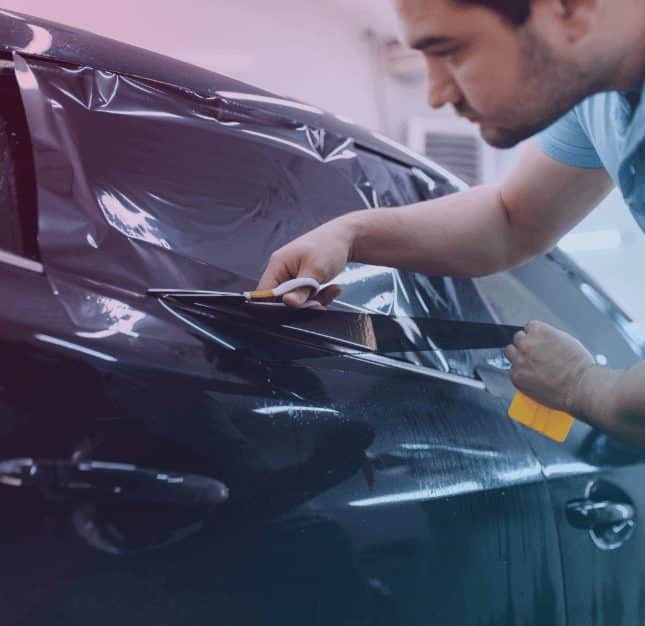Should You Consider automotive window tinting clinton township for Your Next Vehicle Upgrade?
Every little thing You Need to Know Regarding Vehicle Home Window Tinting for Your Car
Auto window tinting is a practical enhancement for many vehicle proprietors. It provides advantages such as enhanced comfort and energy effectiveness. Different color movies deal with different needs and preferences. Nevertheless, recognizing lawful regulations and picking the ideal tint percent is vital. The installation process and proper upkeep additionally play substantial duties in guaranteeing the long life of the tint. What various other factors should one think about prior to making a choice on home window tinting?
Benefits of Auto Window Tinting
Some lorry proprietors may forget it, vehicle window tinting deals countless advantages that boost both the driving experience and the automobile's durability. Among the main advantages is the reduction of heat accumulation inside the automobile, allowing for an extra comfy trip, particularly during warm climate. This can bring about lowered dependence on a/c, enhancing gas efficiency.Additionally, home window tinting gives security against damaging UV rays, which can create skin damage and discolor interior materials gradually. By obstructing these rays, the tint aids preserve the lorry's inside and keep its resale value.Moreover, colored home windows can enhance personal privacy and protection, as they make it much more challenging for outsiders to see inside the car. This added layer of security can discourage possible theft. Overall, vehicle window tinting works as a sensible investment that adds to both comfort and the car's total wellness.
Kinds Of Home Window Color Films
When taking into consideration automobile home window tinting, car proprietors encounter a range of window color movies, each designed to satisfy details requirements and preferences. The initial category is dyed window film, which gives a basic level of privacy and UV protection while being cost-effective. Next, metalized films include tiny metal particles, reflecting heat and enhancing resilience, although they might hinder electronic signals.Ceramic films are an additional choice, recognized for their remarkable warm denial and clearness, using high efficiency without signal disturbance. Crossbreed movies integrate qualities of dyed and metalized films, striking a balance in between cost and functionality. Each sort of home window tint film offers special advantages, permitting lorry proprietors to choose based on their particular needs, such as heat control, appearance, and budget plan factors to consider. Comprehending these alternatives is important for making an informed decision pertaining to auto home window tinting.
Comprehending Lawful Rules
When considering vehicle home window tinting, it is vital to understand the legal policies that control tint darkness restrictions and windshield color requirements. These laws can differ considerably from state to state, affecting what is acceptable for vehicle proprietors. Familiarizing oneself with these legislations warranties conformity and aids prevent potential penalties or charges.
Tint Darkness Limitations
Exactly how can automobile proprietors ensure they remain compliant with neighborhood regulations concerning home window tinting? Recognizing tint darkness limits is crucial. Each state has specific regulations that dictate the allowable levels of darkness for home window colors, which are gauged by Visible Light Transmission (VLT) portions. Generally, front-side windows must allow a greater percent of light contrasted to back home windows. For example, some states might permit only 30% VLT for front windows, while the rear home windows may be allowed to have notably darker tints. To guarantee compliance, car proprietors ought to speak with state standards or local regulation enforcement for precise info. Furthermore, accredited tinting specialists can give insights concerning legal limits, ensuring that lorry proprietors make educated choices.
Windshield Tint Regulations

State-Specific Regulations
Guiding with the landscape of state-specific regulations regarding car home window tinting requires careful interest to information, as policies can vary significantly from one state to another. Each state has its own collection of rules controling allowable color percentages, kinds of products, and placement on automobile windows. For example, some states allow darker colors on rear home windows while banning them on front home windows, while others have stricter overall restrictions. In addition, particular states mandate the usage of certain materials or call for accreditation from installers. Failure to comply with these regulations can lead to fines or the necessity to remove non-compliant color. Vehicle proprietors should consult their state's Division of Electric motor Automobiles or pertinent authority to assure adherence to neighborhood legislations.
Choosing the Right Tint Percent
When choosing the appropriate tint percent for a lorry's windows, one have to think about numerous aspects that affect both looks and functionality. Color percentages usually range from 5% to 70%, with lower percentages offering darker shades and greater percents allowing much more light in. A darker tint can boost personal privacy and minimize glow, while a lighter color can keep visibility and abide by lawful restrictions.Furthermore, personal choice plays a significant function in this decision. Some individuals might favor the sleek appearance of darker colors, while others may prefer a much more open, ventilated feel. In addition, the lorry's purpose should be taken into consideration; for circumstances, those using their cars for industrial functions could go with lighter tints to maintain a professional look.Ultimately, the best tint percent equilibriums individual style, convenience, and adherence to local guidelines, making sure a gratifying tinting experience.
The Installment Process
A successful setup of window tint calls for careful interest to information and the right devices. The procedure typically begins with complete cleaning of the home windows to eliminate imp source dirt, particles, and dust, guaranteeing proper adhesion of the movie. Once the surfaces are prepared, the installer steps and reduces the tint movie to fit each window accurately.Next, the movie is placed on the glass, frequently making use of a service to facilitate simple adjustment and protect against air bubbles. Warmth is in some cases used to the movie to conform it to the window's contours, enhancing its appearance and longevity. After confirming a seamless fit, the installer diligently cuts any kind of excess movie along the edges.Finally, the installer checks for imperfections and verifies all edges are secure. This careful strategy is vital not just for looks but additionally for attaining the preferred efficiency advantages of window tinting, such as UV security and warmth decrease.
Upkeep and Look After Tinted Windows
Correct upkeep and care are crucial for preserving the honesty of tinted home windows. Efficient cleaning techniques, the evasion of harmful chemicals, and regular inspections for damages play vital duties in ensuring long life. By complying with these guidelines, vehicle proprietors can maintain the aesthetic and functional benefits of their home window tint.
Cleaning Up Techniques for Tint
Preserving the quality and durability of tinted windows needs specific cleansing techniques tailored to the film's fragile surface area. It is essential to make use of a soft microfiber towel to prevent scratching the color while cleansing. A mild remedy of water and a couple of drops of mild meal soap can successfully eliminate dust and gunk. It is recommended to apply the cleansing remedy to the fabric, as opposed to directly onto the tinted surface, to prevent wetness from seeping into the edges of the film. Gentle, circular motions ought to be employed to clean the windows extensively. Routine cleansing aids maintain visibility and avoids accumulation, ensuring that the color remains in prime problem with time. Following these methods will certainly extend the life of tinted windows.
Staying Clear Of Unsafe Chemicals
Although numerous home cleaning products work on different surfaces, they can present considerable risks to tinted windows. Chemicals such as ammonia, bleach, and particular solvents can weaken the color film, leading to staining and peeling. People should opt for pH-balanced cleansers especially designed for colored windows. Additionally, utilizing soft microfiber cloths will aid avoid scratches and keep the tint's stability. Routine maintenance is important; consequently, avoiding severe scrubbing or abrasive materials is crucial. It is advisable to review product labels meticulously to confirm compatibility with home window tints. By picking the appropriate cleansing services and tools, automobile proprietors you can look here can protect the look and capability of their tinted windows, guaranteeing a longer life-span and height efficiency.
Examining for Damage
Normal assessments of colored windows are very important for identifying any indications of damages that may jeopardize their effectiveness and appearance. Owners need to seek gurgling, peeling, or staining, as these problems can show bad installation or direct exposure to dangerous elements. It is suggested to check the sides of the film where peeling may begin and evaluate for any kind of scratches that could influence visibility. Additionally, ultraviolet (UV) rays can create the tint to degrade over time, so checking its efficiency in blocking UV light is vital. If any damage is spotted, prompt activity needs to be taken, which may consist of professional repair work or replacement. Keeping tinted home windows not just improves visual appeals however likewise guarantees proceeded protection for both guests and the car interior.
Usual Misconceptions About Home Window Tinting
What mistaken beliefs border home window tinting for lorries? Many individuals think that all window tints are unlawful, however regulations vary by state, enabling specific degrees of tinting. Another usual misconception is that darker colors block even more warmth; nevertheless, the effectiveness of home window films depends on their innovation instead of darkness. Some people additionally think that window tinting is entirely for looks, neglecting its benefits, such as UV defense and glow reduction. In addition, numerous presume that window tinting will harm their lorry's glass, however properly applied tints can really boost glass toughness. There is an idea that home window colors block visibility, yet premium movies are developed to preserve clear sightlines while offering privacy. Recognizing these misconceptions aids consumers make educated decisions regarding home window tinting, ensuring they take pleasure in the full series of advantages it supplies.
Often Asked Inquiries
How Much Time Does Home Window Tinting Usually Last?
The long life of window tinting differs based upon elements such as setup high quality, movie kind, and environmental problems. Commonly, top notch tint can last anywhere from five to 10 years before requiring replacement or reapplication.
Can I Remove Window Color Myself?
Getting rid of home window color oneself is possible, though it may be challenging. Individuals ought to make use of a warmth resource and sticky cleaner to relieve the procedure, but caution is encouraged to stay clear of damaging the vehicle's glass or interior.
What Equipment Are Needed for DIY Window Tinting?

Will Home Window Tinting Damage My Auto's Glass?
Home window tinting, when used appropriately, normally does not harm a cars and truck's glass. Incorrect installment or low-quality films might lead to peeling off, bubbling, or scraping, potentially endangering the integrity of the glass over time.
Can Tinted Windows Affect My Vehicle's Resale Worth?
The effect of tinted windows on a vehicle's resale value can differ. While some purchasers appreciate the added privacy and UV security, others may view it as a possible problem, potentially affecting resale favorably or negatively. When considering car window tinting, vehicle owners experience a variety of window color movies, each created to meet specific needs and preferences. When considering automobile window tinting, it is important to understand the lawful guidelines that control tint darkness restrictions and windscreen color needs. Normally, front-side home windows should allow a greater portion of light contrasted to rear home windows. Some states might enable only 30% VLT for front home windows, while the rear home windows may be allowed to have significantly darker colors. Some click now states allow darker colors on back windows while restricting them on front home windows, while others have stricter overall restrictions.